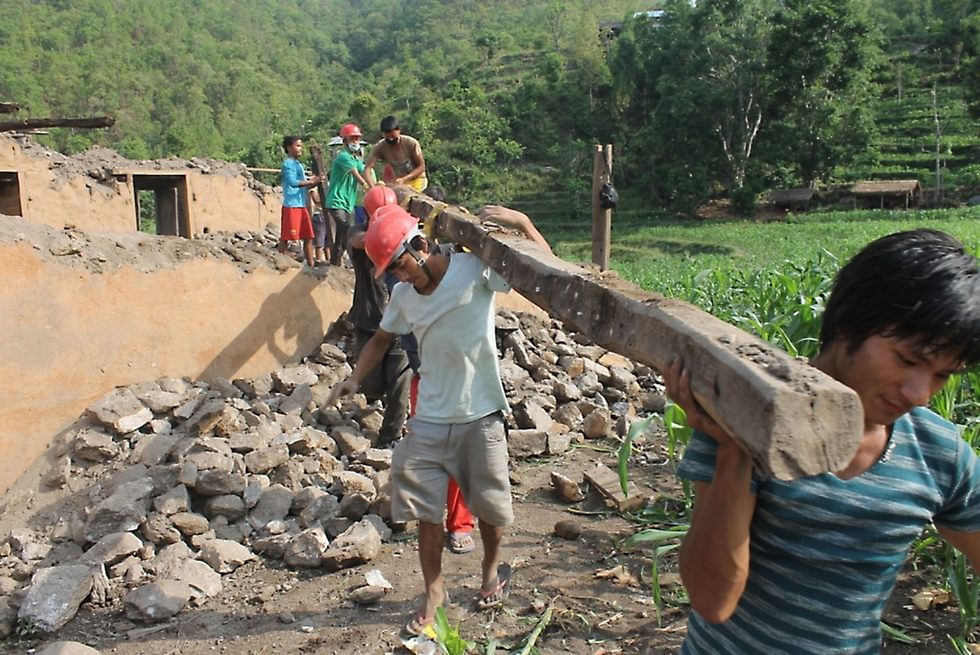The Photographed Gift: Participation, Relief Efforts, and Social Media
From the Series: Aftershocked: Reflections on the 2015 Earthquakes in Nepal
From the Series: Aftershocked: Reflections on the 2015 Earthquakes in Nepal

The first earthquake to shake Nepal in the spring of 2015 happened on Saturday, April 25. Four months later, Nepalis were still experiencing aftershocks, mourning, and working to rebuild their country. As such, the earthquake event continued to unfold into the future, both in Nepal and virtually. During such crises we instinctively turn to social media, especially Facebook, for that ersatz sense of copresence that comes from connecting to survivors, relief workers, and members of our network who are also acutely concerned, even if that connection is a disjointed one spanning time zones. For example, after a series of aftershocks that drove survivors back out of their homes and into the streets, a friend posted photographs of a punishing thunderstorm, thereby heightening our sense of a natural world turned against its human inhabitants. In the era of social media, we experience events like these with distant friends in the near present, expressing concern and sharing information, often in the form of our own photos or links.
This is the new participant-observation: observing an event from afar and participating in the moment through likes, shares, and comments, often drawn to do so by photographs and videos. In this short piece, we focus on photographs of the Nepal earthquake on Facebook that highlight the offline and online activities of one Nepali organization, with whom we have previously worked, in order to capture a sense of the ways in which the democratization and proliferation of visual communication complicates how we experience crises today. In the context of social media, photographs facilitate a heightened degree of interdependence, which, in the Buddhist worldview of our Nepali informants, draws out our empathy and breaks down a sense of self and other. We frame these earthquake photographs as ongoing events, in hopes that conceiving of a photograph as an event space can update the use of visual methods in ethnographic inquiry.
The photographs on Facebook from a Buddhist organization, the Sakya Earthquake Relief Team, demonstrate the special role that the monastic community plays in Tibetan Buddhist society. On the day after the first earthquake, some of the earliest images in our Facebook feeds were of Sakya monks rescuing survivors in the Kopan neighborhood outside of Kathmandu. These images were reminiscent of depictions of Sakya and Kagyu monks rescuing earthquake survivors and providing solace through funerary rituals in Jyekundo (in Chinese, Yushu) in 2010. Eventually calling themselves the Sakya Earthquake Relief Team, the monks donned special T-shirts, hoisted banners on rented trucks, and led relief expeditions on an almost-daily basis to remote places including Sindhupalchowk, Hyolmo, Nuwakot, and Mustang. They also held weekly prayer services for victims and survivors along the circumambulation route of the damaged Boudhanath Stupa, culminating in the performance of a Vairocana ritual for victims, a Homa ritual to prevent those who died particularly violent deaths from becoming malevolent spirits, and a long-life empowerment ceremony for survivors. They also ritually distributed monetary assistance to survivors.
Normally, in the priest-patron relationship, lay Tibetan Buddhists make financial donations to lamas and monks, who are, to use agricultural metaphors, fields from which individuals can then cultivate and reap merit for better rebirth. Sometimes there is a physical reciprocity expressed through being touched by the lama, or through receiving a tangible gift like a red cord to wear around the neck, which symbolizes blessings and protection from negativity. “From the holy hands” indicates not only how extraordinarily uncommon it is for a priest to give a financial gift to a patron, but also how the embodied act of hierarchical exchange, emphasized in text and through their postures, bestows protection from teacher to student. Posted to Facebook, these photographs testify to supporters that donations to assist with earthquake relief are used responsibly. Their agentive character makes possible further exchanges between actors, through likes, shares, and comments, which might lead to further donations out of a desire to express devotion or concern for survivors.
In the second image above, we are struck by the lama’s performance of exchange in front of the camera, but also by the ambiguity of our role as an observer: what is the benefit to others if we comment upon or share this image? There is still a complex distance in the emergent virtual participant-observation. Increasingly, everyday photography is a performative practice related to presence, immediacy, and social networking (Sandbye 2014). The social-media photographic frame has become an event space with an undetermined value and temporal length.
Artist and philosopher Daniel Rubinstein (2005) captures how the convergence of the phone and the camera have altered our notion of a photographic still moment, such that the cameraphone “transforms the duration of the photographic moment, turning the whole social experience into a photographic event.”
Therefore, our analysis should also include the subjects in the photographic frame, thus extending the photographic encounter. We screen-grab to preserve the context: the prayer emoticons, the number of likes, the algorithmically determined advertisement. But this is not a single moment. Like the earthquake itself, the photographic event continues, just as we continually return to watch the likes mount and more comments appear alongside additional images of recovery and relief that flow through our feed.
Larsen, Jonas, and Mette Sandbye. 2014. “Introduction: The New Face of Snapshot Photography.” In Digital Snaps: The New Face of Photography, edited by Jonas Larsen and Mette Sandbye, xv–xxxii. London: I.B. Tauris.
Rubinstein, Daniel. 2005. “Cameraphone Photography: The Death of the Camera and the Arrival of Visible Speech.” Issues in Contemporary Culture and Aesthetics 2, no. 1: 113–18.